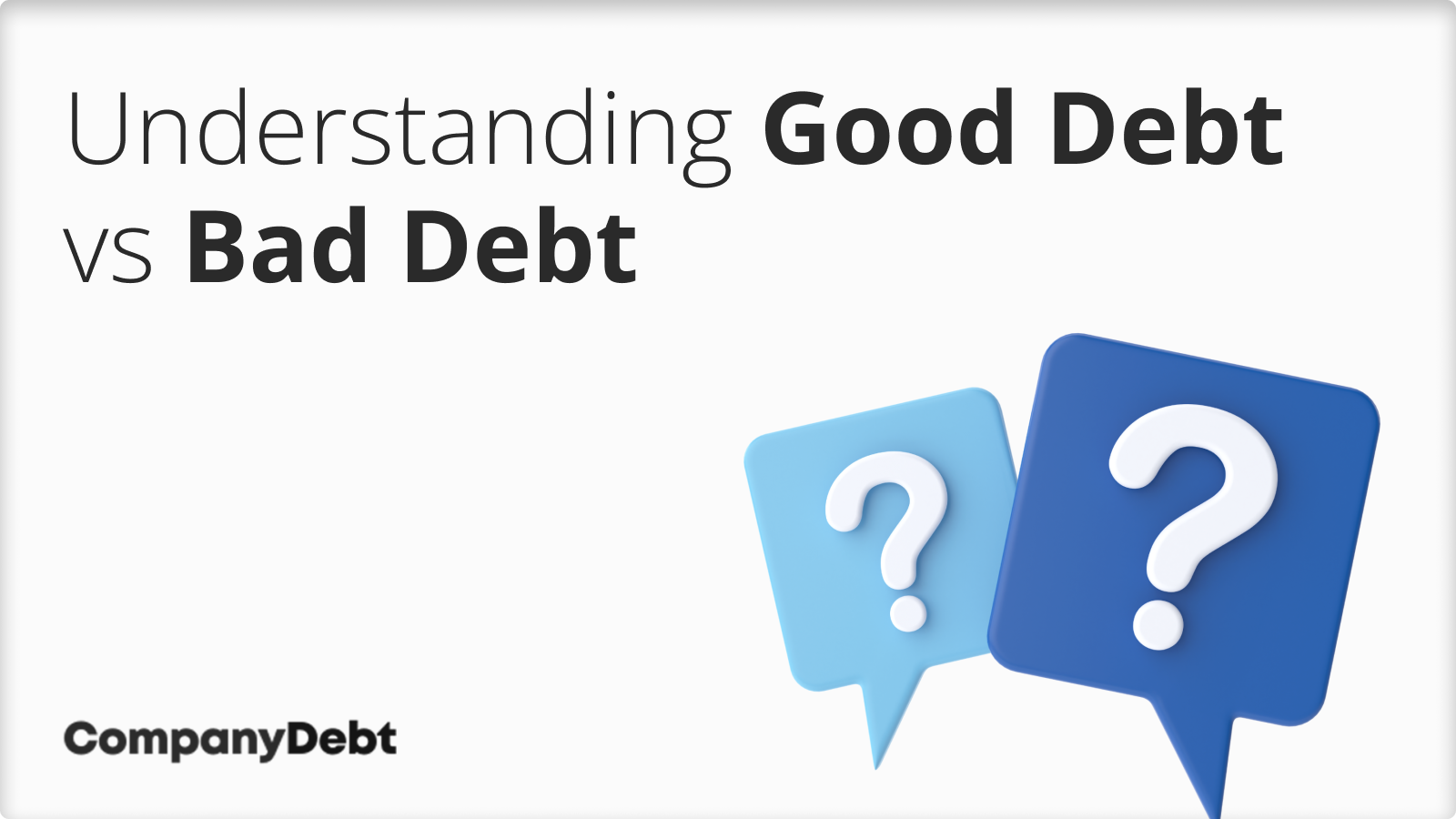
Understanding Good Debt vs Bad Debt
As a corporate insolvency expert, I often encounter businesses grappling with cash flow challenges. My experience has taught me a crucial lesson: debt isn’t always the negative force it’s often perceived to be. In fact, it can be a powerful tool for your business when used wisely.
While periods of negative cash flow typically lead to increased reliance on borrowing, it’s important to recognise that not all debt is created equal. There’s a significant distinction between good debt and bad debt.
Good debt is a strategic investment in your business’s future. It strengthens your company’s long-term position without compromising your overall financial health. With a specific purpose and a realistic repayment plan, it can be an invaluable tool for growth.
By understanding this difference, you can make informed decisions about when and how to leverage borrowing to your advantage, rather than using it solely as a stopgap measure.

- Good Debt vs Bad Debt
- What is Good Debt?
- Scalable
- Offers Competitive Advantage
- Allows You to Seize Opportunities
- Tax Efficient
- Adds Value
- Improved Financial Metrics
- What is Bad Debt?
- Spiralling Interest Costs
- Misalignment with Business Goals
- Cash Flow Strangulation
- Damage to Credit Rating
- Overleverage and Increased Risk
- Hidden Costs and Fees
- Psychological Burden
- Assessing Your Current Debt Profile
Good Debt vs Bad Debt
As a business owner, you’ll encounter various opportunities to take on debt. The key is discerning which debts will propel your company forward and which might hinder your progress.
Good debt acts as a lever for business growth. It’s an investment that generates long-term value, enhancing your company’s profitability or operational efficiency. This type of debt typically offers returns that outweigh the cost of borrowing.
Bad debt, conversely, can be a significant drain on your business resources. It often stems from poor financial management or unforeseen circumstances and doesn’t contribute to your company’s growth or revenue generation.
| Good Debt | Bad Debt |
|---|---|
| Business loans for expansion | High-interest credit card debt |
| Equipment financing for essential machinery | Payday loans |
| Commercial property mortgages for business premises | Unauthorised overdrafts |
| Investment in technology or software for efficiency | Personal loans used for non-business purposes |
| Trade finance for importing goods | Hire purchase agreements with high interest rates |
| Loans for hiring skilled staff to support growth | Using loans to cover operational losses |
What is Good Debt?
Good debt possesses several key qualities that can significantly benefit your business:
Scalable
Good debt enables your business to grow more rapidly than relying solely on organic growth. By providing necessary capital, it supports expansion efforts, allowing you to scale operations, increase production, and boost turnover. For instance, a manufacturing company might use a loan to invest in advanced equipment, significantly increasing production capacity without a proportional increase in labour costs.
Offers Competitive Advantage
Access to additional funds can help your business outmanoeuvre competitors, enter new markets, or invest in innovation. This could involve developing new technologies, improving your product offerings, or enhancing your service capabilities in ways that set you apart from competitors.
Allows You to Seize Opportunities
Good debt provides the financial flexibility to capitalise on time-sensitive business opportunities. Whether it’s acquiring a competitor, launching a new product, or expanding your service offerings, having access to funds when needed can be crucial for growth. This might mean being able to quickly secure a prime high street location when it becomes available or rapidly scaling up production to meet a sudden increase in demand.
Tax Efficient
Often, the interest on business loans is tax-deductible, which can reduce your overall tax burden. This aspect of good debt can provide significant savings, especially for businesses investing heavily in growth or research and development. It’s worth consulting with your accountant to understand the full tax implications for your specific situation.
Adds Value
Good debt typically results in the acquisition of assets that add long-term value to your business. Whether it’s purchasing new equipment, upgrading technology, or investing in property, these assets can enhance your business’s operational efficiency and profitability. For example, investing in more energy-efficient machinery could reduce operating costs over time.
Improved Financial Metrics
Strategic use of debt can enhance your company’s financial ratios, such as return on equity (ROE) and return on assets (ROA), by leveraging borrowed funds to generate higher profits. This can make your business more attractive to potential investors and lenders in the future.
Real-world examples of good debt in action:
- A manufacturing firm borrows to invest in automated equipment, increasing output and reducing long-term costs.
- A tech startup secures a loan to fund the final stages of product development before a lucrative market launch.
- A retail business uses debt finance to open new locations, expanding its customer base and revenue streams.
What is Bad Debt?
While good debt can fuel your business growth, bad debt can seriously hinder your company’s financial health and operational capabilities.
Typically, bad debt refers to borrowed funds that don’t contribute to your company’s growth or profitability. These debts often arise from poor financial decisions or unforeseen circumstances.
Spiralling Interest Costs
Bad debt often comes with high interest rates that can quickly snowball, eating into your profits and cash flow. For instance, relying on business credit cards or payday loans for day-to-day operations can lead to a situation where you’re paying more in interest than you’re able to generate in profit.
Misalignment with Business Goals
Taking on debt for purposes that don’t align with your core business objectives or growth strategy can be detrimental. This might include borrowing to fund vanity projects or non-essential expenses that don’t contribute to your bottom line or competitive position.
Cash Flow Strangulation
Bad debt can severely constrain your cash flow, leaving you struggling to meet routine operational expenses or unable to invest in growth opportunities. This can create a vicious cycle where you’re forced to take on more debt just to stay afloat.
Damage to Credit Rating
Difficulty in repaying bad debt can lead to missed payments or defaults, which can severely damage your business credit rating. This can have long-lasting consequences, making it harder and more expensive to secure financing in the future, even for worthwhile investments.
Overleverage and Increased Risk
Accumulating too much bad debt can leave your business overleveraged, increasing your vulnerability to market downturns or unexpected challenges. This heightened financial risk can make it difficult to weather tough times or economic uncertainties.
Hidden Costs and Fees
Bad debt often comes with hidden costs and fees that can catch you off guard. These might include early repayment penalties, processing fees, or variable interest rates that can suddenly increase. Always read the fine print and understand the total cost of any debt you’re considering.
Psychological Burden
The stress of managing bad debt can take a toll on business owners and employees alike. It can lead to poor decision-making, risk aversion, and a focus on short-term survival rather than long-term growth and innovation.
Common examples of bad debt in business settings:
- Using credit cards to finance day-to-day operations
- Taking out loans to pay for extravagant office renovations
- Borrowing to fund excessive inventory that ties up working capital
- Using new loans to pay off existing debts without addressing underlying issues
Bad debt can quickly spiral out of control, leading to cash flow problems, damaged credit ratings, and in severe cases, insolvency. It’s vital that you recognise the signs of bad debt early and take swift action to mitigate its impact on your business.
Assessing Your Current Debt Profile
Start by compiling a comprehensive list of all your current debts. For each, note the principal amount, interest rate and terms, purpose of the debt, and current repayment status. This overview will form the foundation of your assessment.
Next, evaluate each debt against key criteria. Consider the return on investment: is the debt generating more value than its cost? Assess its strategic alignment: does it support your business goals? Examine the cash flow impact: how does it affect your monthly finances? Finally, consider the risk level: what’s the potential impact if you struggle to repay?
Use this analysis to categorise your debts as ‘good’ or ‘bad’. Good debts will typically show positive returns, align with your strategy, have manageable cash flow impacts, and pose acceptable risks.
If you identify bad debts, prioritise these for rapid repayment or restructuring. You might consider consolidating high-interest debts or negotiating better terms with lenders.
Remember, your debt profile isn’t static. Regular reassessment is key to maintaining a healthy financial position. Set a schedule to review your debt profile quarterly, adjusting your strategy as your business evolves.
How can we help?
Of course, while there are a number of benefits associated with debt, there are also serious risks. Our company rescue experts have turned around profitable companies that sourced too much debt too quickly. Those in riskier business sectors may also have a higher cost of debt, which can prove problematic.
At Company Debt, we can help businesses avoid cash-flow problems in the first instance, and source alternative forms of finance to help you grow. Please call 0800 074 6757 for no-obligation business debt advice.








